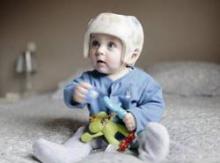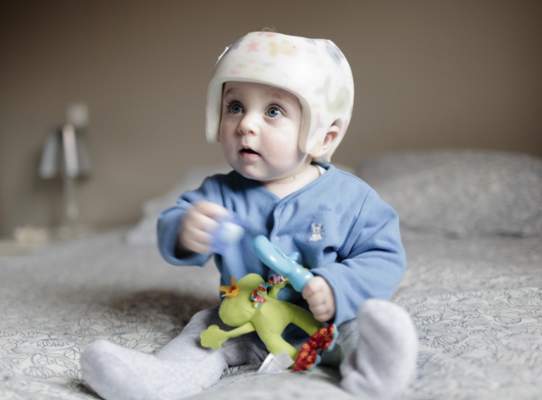User login
Both helmet therapy and conservative therapy were effective in correcting most positional cranial deformation, based on a study of 4,378 infants diagnosed with either deformational plagiocephaly or deformational brachycephaly between 2004 and 2011.
In a nonrandomized study, 3,381 infants received conservative therapy, which consisted of repositioning with or without physical therapy, and 997 received helmet therapy. Of infants who received conservative therapy alone, 77% achieved complete correction. The other 534 infants were transitioned to helmet therapy after failure to respond to conservative therapy alone. Among these “crossover” patients, 96% achieved complete correction.
In infants who received helmet therapy alone, over 94% achieved complete correction, Dr. Jordan P. Steinberg and colleagues wrote in a study published in Plastic and Reconstructive Surgery.
Compared with infants who received conservative treatment alone, crossover patients had greater deformity, with an increased cranial ratio (0.94 ± 0.35 versus 0.91 ± 0.23; P = .012) and diagonal difference (10.3 ± 4.1 versus 9.0 ± 3.8; P < .001) at the start of therapy (Plast. Reconstr. Surg. 2015;135:833-42).
Parents were more likely to comply with helmet therapy than with conservative therapy, 94% versus 87% respectively (P = .001). For the infants crossed over to helmet therapy, parent compliance was 84% with positional therapy and 96% with helmet therapy (P < .001).
Noncompliant parents had infants who were 2.4 times more likely to fail helmet therapy (P = .025) than were compliant parents, the authors reported.
Risk factors for failing conservative therapy were poor compliance (RR = 2.4; P = .009), older infant age (RR 1.76-2.08; P = .008), torticollis (RR 1.12-1.74; P = .002), developmental delay (RR 1.44; P = .042), and increased severity of cranial deformity, indicated by cranial ratio (RR 1.08-1.11; P = .044) and diagonal difference (RR 1.07-1.13; P = .027).
The presence of these factors may be a guide to initiating helmet therapy from the outset of treatment, rather than initially undertaking a course of conservative treatment, the researchers said. Delaying helmet therapy in favor of first-line conservative treatment for positional cranial deformation does not hinder complete correction, as long as parents are compliant with positional therapy and helmet therapy is begun in nonresponders while the infants’ brain growth is ongoing.
The greatest limitation of the study, they wrote, is that treatments were not randomized, so conclusions cannot be made about which therapy may be more effective.
Dr. Steinberg and his coauthors did not report any relevant financial disclosures.
Both helmet therapy and conservative therapy were effective in correcting most positional cranial deformation, based on a study of 4,378 infants diagnosed with either deformational plagiocephaly or deformational brachycephaly between 2004 and 2011.
In a nonrandomized study, 3,381 infants received conservative therapy, which consisted of repositioning with or without physical therapy, and 997 received helmet therapy. Of infants who received conservative therapy alone, 77% achieved complete correction. The other 534 infants were transitioned to helmet therapy after failure to respond to conservative therapy alone. Among these “crossover” patients, 96% achieved complete correction.
In infants who received helmet therapy alone, over 94% achieved complete correction, Dr. Jordan P. Steinberg and colleagues wrote in a study published in Plastic and Reconstructive Surgery.
Compared with infants who received conservative treatment alone, crossover patients had greater deformity, with an increased cranial ratio (0.94 ± 0.35 versus 0.91 ± 0.23; P = .012) and diagonal difference (10.3 ± 4.1 versus 9.0 ± 3.8; P < .001) at the start of therapy (Plast. Reconstr. Surg. 2015;135:833-42).
Parents were more likely to comply with helmet therapy than with conservative therapy, 94% versus 87% respectively (P = .001). For the infants crossed over to helmet therapy, parent compliance was 84% with positional therapy and 96% with helmet therapy (P < .001).
Noncompliant parents had infants who were 2.4 times more likely to fail helmet therapy (P = .025) than were compliant parents, the authors reported.
Risk factors for failing conservative therapy were poor compliance (RR = 2.4; P = .009), older infant age (RR 1.76-2.08; P = .008), torticollis (RR 1.12-1.74; P = .002), developmental delay (RR 1.44; P = .042), and increased severity of cranial deformity, indicated by cranial ratio (RR 1.08-1.11; P = .044) and diagonal difference (RR 1.07-1.13; P = .027).
The presence of these factors may be a guide to initiating helmet therapy from the outset of treatment, rather than initially undertaking a course of conservative treatment, the researchers said. Delaying helmet therapy in favor of first-line conservative treatment for positional cranial deformation does not hinder complete correction, as long as parents are compliant with positional therapy and helmet therapy is begun in nonresponders while the infants’ brain growth is ongoing.
The greatest limitation of the study, they wrote, is that treatments were not randomized, so conclusions cannot be made about which therapy may be more effective.
Dr. Steinberg and his coauthors did not report any relevant financial disclosures.
Both helmet therapy and conservative therapy were effective in correcting most positional cranial deformation, based on a study of 4,378 infants diagnosed with either deformational plagiocephaly or deformational brachycephaly between 2004 and 2011.
In a nonrandomized study, 3,381 infants received conservative therapy, which consisted of repositioning with or without physical therapy, and 997 received helmet therapy. Of infants who received conservative therapy alone, 77% achieved complete correction. The other 534 infants were transitioned to helmet therapy after failure to respond to conservative therapy alone. Among these “crossover” patients, 96% achieved complete correction.
In infants who received helmet therapy alone, over 94% achieved complete correction, Dr. Jordan P. Steinberg and colleagues wrote in a study published in Plastic and Reconstructive Surgery.
Compared with infants who received conservative treatment alone, crossover patients had greater deformity, with an increased cranial ratio (0.94 ± 0.35 versus 0.91 ± 0.23; P = .012) and diagonal difference (10.3 ± 4.1 versus 9.0 ± 3.8; P < .001) at the start of therapy (Plast. Reconstr. Surg. 2015;135:833-42).
Parents were more likely to comply with helmet therapy than with conservative therapy, 94% versus 87% respectively (P = .001). For the infants crossed over to helmet therapy, parent compliance was 84% with positional therapy and 96% with helmet therapy (P < .001).
Noncompliant parents had infants who were 2.4 times more likely to fail helmet therapy (P = .025) than were compliant parents, the authors reported.
Risk factors for failing conservative therapy were poor compliance (RR = 2.4; P = .009), older infant age (RR 1.76-2.08; P = .008), torticollis (RR 1.12-1.74; P = .002), developmental delay (RR 1.44; P = .042), and increased severity of cranial deformity, indicated by cranial ratio (RR 1.08-1.11; P = .044) and diagonal difference (RR 1.07-1.13; P = .027).
The presence of these factors may be a guide to initiating helmet therapy from the outset of treatment, rather than initially undertaking a course of conservative treatment, the researchers said. Delaying helmet therapy in favor of first-line conservative treatment for positional cranial deformation does not hinder complete correction, as long as parents are compliant with positional therapy and helmet therapy is begun in nonresponders while the infants’ brain growth is ongoing.
The greatest limitation of the study, they wrote, is that treatments were not randomized, so conclusions cannot be made about which therapy may be more effective.
Dr. Steinberg and his coauthors did not report any relevant financial disclosures.
FROM PLASTIC AND RECONSTRUCTIVE SURGERY
Key clinical point: Helmet therapy and conservative therapy with repositioning and/or physical therapy were equally effective in correcting deformational plagiocephaly and brachycephaly.
Major finding: In infants who received helmet therapy alone, 94% achieved complete correction; 77% of patients who received conservative therapy alone achieved complete correction, and an additional 16% achieved complete correction after transitioning to helmet therapy.
Data source: A study of 4,378 infants evaluated for positional cranial deformation and assigned to either conservative or helmet therapy between 2004 and 2011.
Disclosures: The authors did not report any relevant financial disclosures.

